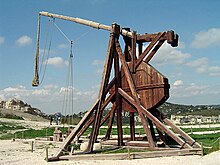Counterweight (mechanics)
A counterweight is a body of a certain mass , which mostly serves to compensate for forces or torques acting on one side due to geometrically asymmetrical designs or weight distributions. It is mostly intended to ensure the stability of bodies or objects or to facilitate the mechanical use of lifting devices.
Guarantee of tipping safety
For an object standing freely on a surface there is a tendency or danger of tipping if a weight acts on it in the vertical direction on a point outside the contact area. One example is tower cranes , mobile cranes , charged with load trucks or counterweights in astronomical telescopes and telescopes . In such cases, a correspondingly large counterweight with a suitable arrangement can ensure or improve the static equilibrium or the stability against tipping . The mathematical treatment of the optimal size and the arrangement of the counterweight results from the lever law . An alternative to counterweights for stationary, immovable objects would be a rope anchoring against the floor or against the supporting structure.
Relief or energy savings when lifting loads
In the case of cable lifts and bascule bridges, etc., a counterweight can be attached to the extension of the pull cable or the folding part beyond the pivot point, which is as large as possible as the lifting load. In the best case scenario, the drive only has to overcome the mechanical friction of the lifting mechanism (pulley or axis of rotation). However, the loads are often variable (for example due to the changing number of people in elevators) and an exact comparison is not made. In this case, the drive sometimes has to provide additional power for the real lifting work.
Avoidance of unbalance
Vehicle wheels and other rotating bodies (e.g. crank webs of crankshafts ) can deviate from a rotationally symmetrical weight distribution to a greater or lesser extent, randomly or due to constructional reasons. At high speeds or greater deviations in weight, mostly due to design, imbalances result which can have a long-term destructive effect. In this case, counterweights attached to the wheel or rotating body can ensure that the axis of rotation is as identical as possible to the main axis of inertia. This process is called " balancing ".
Counterweights were also used on the wheels of steam locomotives to balance the masses , whereby in this case not only the asymmetries of the wheel bodies, but also the heavy coupling rods and connecting rods attached to the pivot pins have to be “compensated”.
Use of centrifugal force
The medieval throwing weapon Blide had a throwing arm with a very heavy counterweight attached in the extension behind the axis of rotation. When the lock was released, this gave the relatively light throwing arm a sufficiently fast turning movement, after which centrifugal force ultimately let the projectile snap out of the open rope loop.
In a theoretically conceivable space elevator , a counterweight should be used to suspend a rope on which loads can be transported into space. The counterweight ensures that the center of gravity of the rope is on the geostationary orbit so that the centrifugal force balances the force of gravity.
Control of oscillating movement
A wind-up metronome has a sliding weight that is attached to a pendulum. The pendulum is kept swinging by a spring mechanism. The speed of the oscillation can be adjusted by the position of the weight .








